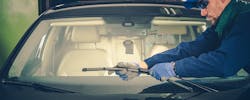It is 1980 and I have just started a job with an auto parts manufacturer who provides a variety of parts — one being windshield wipers. Since that time, I have been involved in wiper sales, marketing, development, testing, distribution and trouble-shooting. Thirty-eight years later, installers sometimes ask me what to look for in a high-performing windshield wiper, and my answer is, “Please take a moment to think about it.” Then, I explain what I mean.
Wipers are a compromise. Think about it — most aftermarket wiper suppliers offer one wiper blade in a package that usually has a number of connectors, or sometimes a connector that fits a variety of wiper arms. This blade fits numerous different applications, each with different windshield curvatures, body aerodynamics, wind-lift effects, wiper arm pressures and wiper system linkage components — even the operating direction and park positions of the wiper blade can vary. Most times, this one blade is listed for cars, SUVs, vans, light trucks and medium- to heavy-duty trucks. One blade is supposed to work perfectly on every application? I have not found one that will. You stand as much chance of winning the Powerball lottery than one blade working perfectly on all of these different types of vehicles. Your best option is selecting a wiper blade that most closely resembles the design of the original wiper blade that was engineered for the vehicle.
Recently, a number of wiper marketers have presented the beam blade wiper style as solving or improving wiper performance on all applications. It is possible to experience an improvement on select applications, but it is more likely that a new problem is created when an original standard frame blade is replaced by a beam blade. Think about it — the profile of the standard frame blade is straight, and the beam is curved. To ensure rubber-to-windshield contact the entire length of the wiping edge, the beam blade can require more downward arm pressure than a standard frame blade. To further compound the problem, standard frame blades are found on all older cars (over 15 years old), and wiper arms naturally lose spring tension over time. An older weakened wiper arm coupled with a blade that requires more pressure than the original blade is a formula for possible wiping problems.
Some aftermarket wiper manufacturers offer styles of wipers that have never been used at OE and tout the design as an “improvement.” We have always contended that if a design or material is not used at OE, it’s generally not an improvement, but rather a gimmick. The most drastic design variation is the multi-edge rubber where more than one wiping edge is contacting the windshield during the entire sweep. We also witnessed wiper performance problems when the original blade is replaced by a blade just a little longer. The wiping system, including the motor, is designed to operate with a certain amount of friction between the rubber and the glass. Friction can increase even if the blade is two or three inches longer than the original. If that rubber wiping edge is doubled or tripled, the friction is doubled or tripled, and increased friction increases the strain on the system — especially the wiper motor. Stick with the original length blade and one wiping edge to minimize wiping problems.
Think about it — just because a wiper works on your vehicle does not mean it will work well on every other. A number of years ago, I was involved in a project designing a blade that worked well on a Dodge Caravan, because preventing wind-lift at higher speeds was a challenge on this model. We settled on a design that incorporated molded “wind channel ports” in the frame of the blade. These ports did an outstanding job of using the wind to increase pressure on the blade, keeping the rubber on the Caravan’s windshield at speeds over 70 miles per hour. This would be a great wiper advancement for all vehicles, right? Wrong. We tried the same style blade on the two most popular passenger cars at the time, and the results were disastrous. During operation, the aerodynamics of the Ford Taurus actually lifted the blade off the windshield, and it smacked back down on the glass. Pretty scary experience while driving in the rain! The Honda Accord presented a different problem — noise. Not squealing or chatter, but a whistle produced by the oncoming wind going through the wind channel ports. Needless to say, we had to go back to the drawing board and change the design of the frame to one that was not so drastic. In other words, a compromise. Wiper design is always a compromise. When looking for a wiper blade that will cause you the least amount of problems, you would do well in testing them on as many different vehicles as possible. You cannot try all vehicles, but a test on different popular vehicle styles would be advisable.
Besides the blades themselves, the windshield can have a tremendous effect on wiper performance, especially when it comes to friction. Think about it — wiper manufacturers test the wiping performance on glass, not wax, not windshield treatments, not bugs and road tar. They only test on glass. So, when wiping problems occur, make sure your blade is wiping glass. While road tar and bugs can present wiper problems, the most common culprit is the wax that is applied by automatic car washes. You would think that wax would create a slicker surface and decrease friction, but usually, wax on a windshield will increase friction and could lead to squealing and chatter. In order to remove the wax or road tar, you can use a very mild cleanser like Bon Ami (not standard cleanser), but I have found that to be messy. I use what we used in the wiper test labs, #0000 steel wool and standard windshield washer fluid. MAKE SURE IT IS #0000 STEEL WOOL! Any coarser grade, and you will scratch the heck out of the glass. Rub in swirling motions; it could take two or three cleanings to get heavy wax buildup, but it does come off. Bottom line — wipers are designed to clean glass.
I am asked how long wipers should last. There is no answer to that question, because wiper life is mostly determined by its environment. I have seen wipers that baked on the windshield in Phoenix for six months and were shot. Others in the Northwest have been used (almost daily) for two years and still have life. The good news is that auto manufacturers have provided a wiper wear detection device on every vehicle since wipers were developed in 1903 — it’s called a windshield. How does one know when they need wipers? Look at the windshield! If there are any streaks, smearing or you cannot clearly see through, it is time for new wipers.
But that does not mean all approach this subject with common sense. One wiper manufacturer put an indicator on the wiper blade that changed color over time telling the consumer they needed new wipers. In reality, this indicator changed color with light over time, and it had nothing to do with the actual wear of the rubber. Other wiper manufacturers advise you to change wipers every six months to ensure you always have good wipers. This would be like replacing all the lighting on your vehicle each year to ensure you will never have a bulb burn out. Think about it — checking wiper performance is easy; just look at the windshield for an answer. If you cannot see clearly, replace the wipers.
One more “think about it.” Choosing the right wiper to install on your customer’s car could be one of the most important decisions your business could make. How many parts or products do your customers see in operation after you have installed them? Every time it rains and the wipers come on, the quality of wiper performance could be a direct reflection on how a customer perceives your entire business. A poor performing wiper could lead your customer to wonder what type of oil or filter you used on their vehicle. They can wonder if the flush service you performed was done properly and completely. They can wonder if the new battery you installed will meet their expectations in frigid weather. The best scenario is that the wipers you installed operate quietly and the driver sees clearly, so the driver does not even notice them.
After 38 years, I finally realized the key to operating a successful windshield wiper service is common sense. Think about it.
About the Author

